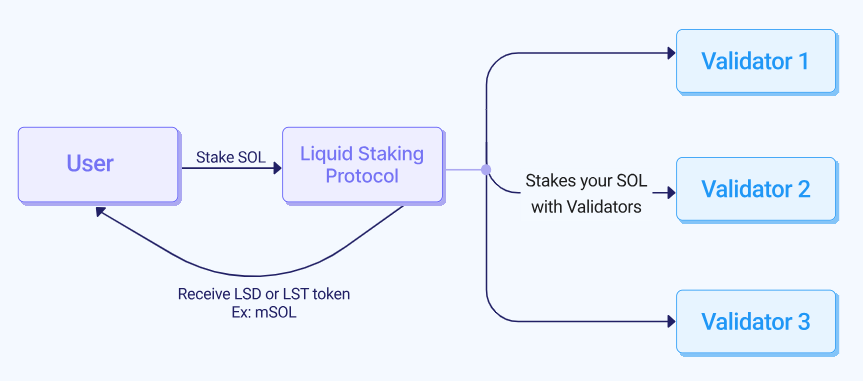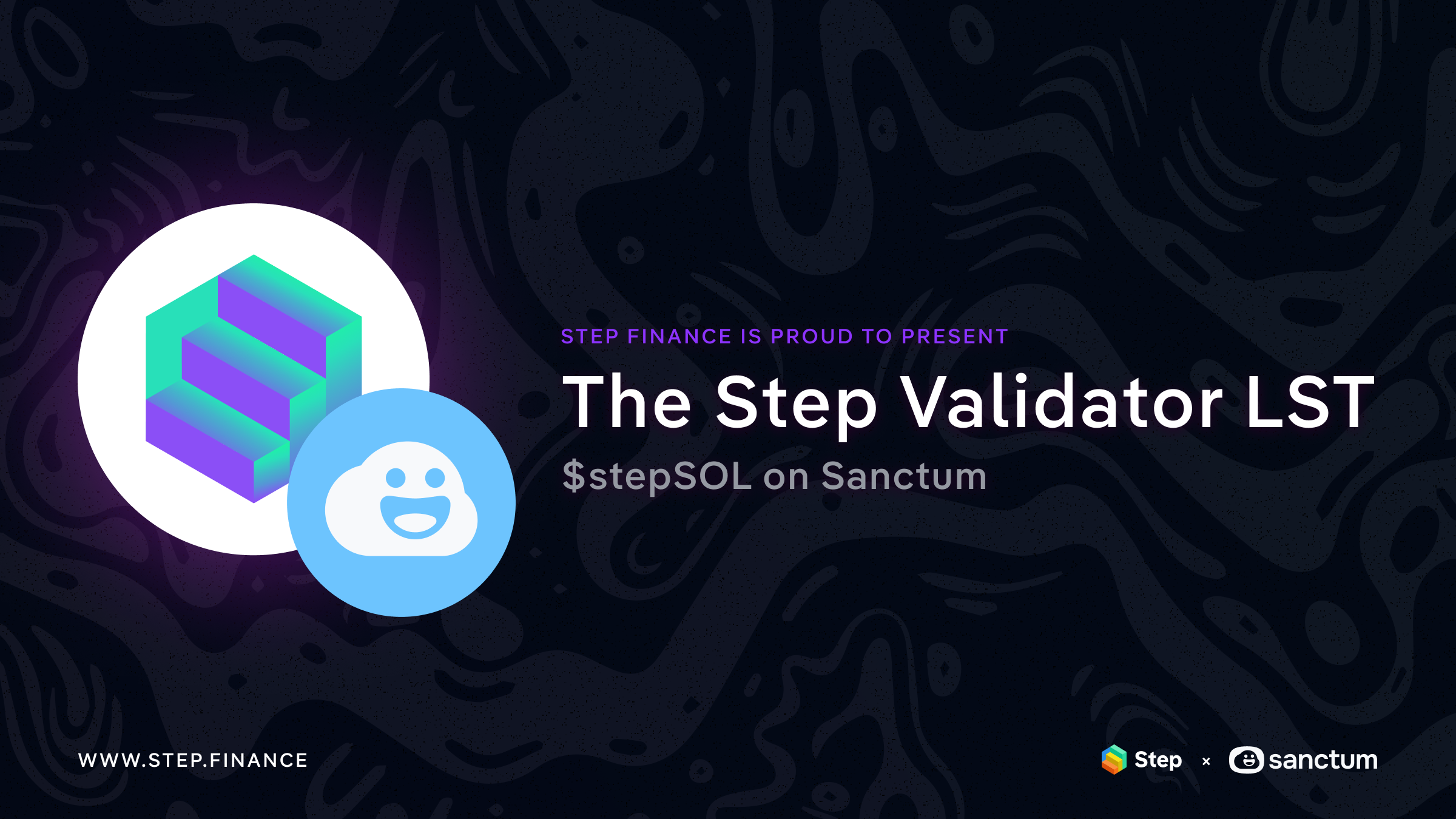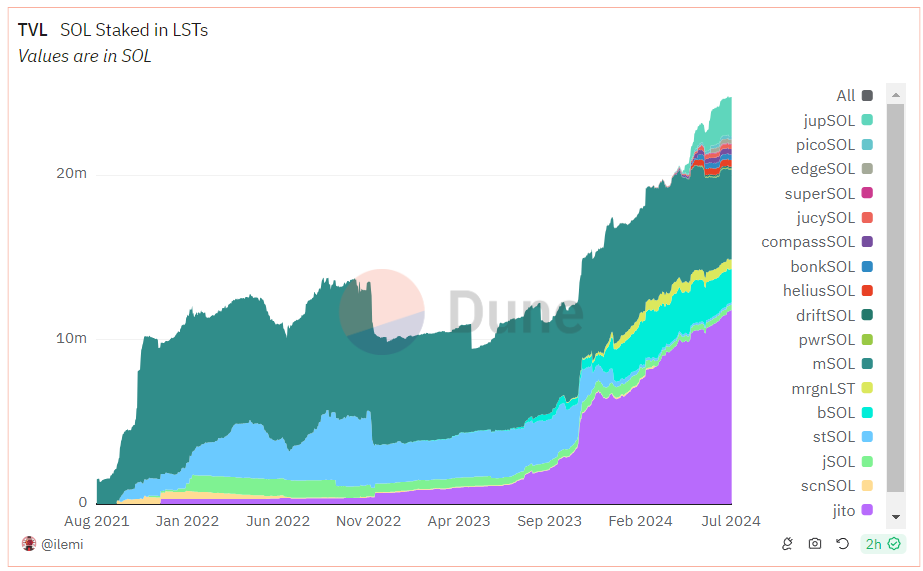
Only 6.4% of Staked SOL is Liquid Staked: A Missed Opportunity?
A cornerstone of Solana DeFi, LSTs secure and decentralize the network while optimizing capital efficiency. With new opportunities like stepSOL launching, why is this powerful tool so underutilized?
- Published:
- Edited:
Breaking new all-time highs in TVL every month this year, Solana LSTs (Liquid Staking Tokens) have established themselves as one of the fundamental pillars of the ecosystem.
Yet, despite its growing popularity and the wealth of benefits, only 6.4% of all staked SOL is liquid staked, suggesting plenty of Solana users still have some lingering questions about LSTs.
What is liquid staking on Solana? How do Solana LSTs work and why should Solana users consider leveraging LSTs to optimize their DeFi strategies?
With one of Solana's longest-standing protocols launching liquid staking services, there's never been a better time to refresh your knowledge.
What is Liquid Staking on Solana?
Traditionally, native staking your SOL tokens to a validator is an excellent way of earning passive rewards and contributing to network security and decentralization. While native staking is an essential component of any Proof-of-Stake blockchain, it has one key drawback:
Once your SOL is staked, it becomes inaccessible and you can’t do anything with it.
Liquid staking providers offer you the best of both worlds. By liquid staking your SOL tokens, not only do you continue to accumulate staking rewards and secure the network, but you also receive LSTs in exchange that represent your stake in the blockchain.
These LSTs can further be used across the Solana ecosystem, unlocking maximum capital efficiency and letting you do more with your digital assets. But how does it all work under the hood?
How Does Liquid Staking Work?
The easiest way to think of LST tokens is to imagine them like an IOU. When you liquid stake your SOL tokens with a staking provider like Marinade or Jito, you’re essentially letting them delegate your staked SOL in return for a tradable asset.

These protocols will automatically delegate your staked SOL to a stake pool, or a collection of validator nodes that work to verify transactions on the Solana blockchain and secure the network.
In return, you’ll receive a liquid asset, like mSOL, that represents an equivalent amount of staked SOL. These LST tokens can be immediately redeemed without needing to wait lengthy unstaking periods. What’s more, your LST tokens are like any other SPL token and can be used across the Solana ecosystem in various DeFi applications to generate yield.
What is Liquid Staking MEV?
MEV, or Maximum Extractable Value, is an umbrella term that covers a range of profit-generation strategies and arbitrage opportunities that occur within block production.
For example, by rearranging the order of transactions within a processing queue, MEV tools can profit from mismatched prices in liquidity pools across different DEXes. Some Liquid Staking providers, like Jito, eliminate MEV spam transactions and pass these rewards on to stakers, effectively boosting their staking rewards.
To date, Jito has captured over 31,000 SOL in MEV fees, sharing a percentage of these fees with over 100,000 active accounts who liquid stake their SOL tokens through the Jito protocol.
What are the Benefits of Liquid Staking?
Liquid staking has become a key component of Solana’s DeFi landscape, and for good reason. Here’s why:
-
Earn staking rewards without locking SOL - Solana LSTs make it possible to continue earning generous staking rewards, without losing immediate access to your staked assets.
-
Expanded liquidity and DeFi strategies - Users can leverage their LSTs to capitalize on DeFi yield generation strategies, while still earning staking rewards.
-
Contribute to Solana’s security and decentralization - By liquid staking SOL tokens, users help to further decentralize and secure the Solana network by delegating SOL across a variety of validators.
What are the Risks of Liquid Staking?
While there are plenty of reasons to use liquid staking on Solana, it’s not without its flaws. Some of the risks associated with Solana LSTs include:
-
Smart contract risk - LST protocols rely on smart contracts to operate. If any of these contracts is exploited by a malicious actor, stakers could be a risk of losing their funds.
-
LST price depeg - Despite typically maintaining their pegged value, LST tokens on other blockchains have fallen victim to temporary price depegs in the past. This could be problematic during black swan events or periods of market turmoil.
Where Can I Liquid Stake my SOL Tokens?
Now that you’ve got a better understanding of how liquid staking on Solana works, let’s recap some of the most reliable and trustworthy liquid staking providers in the market
Announcing stepSOL - Powered by Step Finance & Sanctum

Entering Solana's flourishing LST landscape for the first time, Step Finance is one of the oldest Solana applications in the ecosystem. Doubling as an intuitive portfolio dashboard and a comprehensive DeFi and NFT analytics platform, Step recently expanded its extensive product offering to include its LST, stepSOL.
On top of earning generous APY, stepSOL holders are also eligible to earn additional STEP Reward Options, which are claimable every five days via the Step Finance dashboard. Stakers who've already delegated their SOL to the Step Validator can head to Sanctum's Stake Accounts page and convert their stake account to stepSOL.
What's more, Step Finance has partnered with Meteora and will be offering incentivized rewards through the following pools:
- STEP/stepSOL
- xSTEP/stepSOL
- stepSOL/edgeSOL
Holding stepSOL enables users to earn generous staking rewards on their SOL holdings, without locking up their digital assets in lengthy staking contracts. What's more, swapping SOL for stepSOL helps decentralize the Solana blockchain and support one of the network's longest-running validators.
Disclaimer: SolanaFloor is owned and operated by Step Finance
Marinade

While Jito may boast the highest value of total deposits, Marinade Finance is arguably the most popular Solana LST provider in terms of users. A true OG of Solana’s DeFi ecosystem, Marinade boasts over 149,000 active users, making it the largest liquid staking provider in the ecosystem.
What’s more, Marinade also offers generous APY on automated native SOL staking, a market forecast to witness 20x growth in the future.
Sanctum

A relative newcomer to the Solana LST ecosystem, Sanctum aims to build an ‘infinite LST’ future. Envisioning a diversified and liquid ecosystem, Sanctum allows users to instantly transfer stake accounts from one LST provider to another, facilitating greater flexibility across different pools and greatly expanding the LST landscape.
TLDR
-
Solana LSTs are a tokenized representation of an equivalent value of staked SOL.
-
These digital assets allow users to earn staking rewards, while still being able to leverage the value of staked assets in Solana’s DeFi ecosystem.
-
Solana LSTs help to secure and decentralize the network and give holders greater flexibility and control over their stake.
The Solana LST landscape has gone from strength to strength throughout the year, breaking new all-time highs in TVL every month and showing no signs of slowing down.
With the prospect of a Solana ETF on the horizon and only 6.4% of staked SOL being liquid-staked, this thriving area of Solana is only anticipated to grow in the future.
Disclaimer: SolanaFloor is owned and operated by Step Finance
Read More on SolanaFloor
OG Solana lending platform evolves, adapting its services to an expanding DeFi landscape
Solend Rebrands to Save, Announcing Diversified New Product Suite



